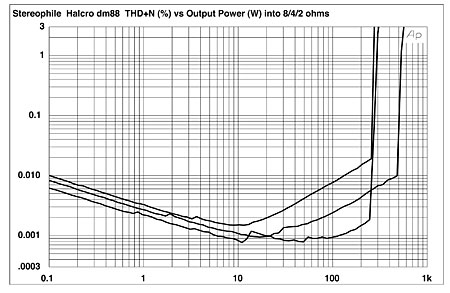I understand you like the aesthetic of this brand (I think it's a bit silly, and a bit out-there if I had people over wondering wtf I got set up in my living room). But I'm just confused. Where are the SINAD comparisons? Maybe I'm just illiterate, but looking at some of the measurements on Stereophile, I'm not seeing how this is as superior.
The new stuff on the site is just a big question mark.
The DM88 (the supposed top spec of the time), I took a look at measurements quickly to see what I can compare with in terms of Amir's metrics
THD+N into 4 ohm for example (since I'm not seeing straight up SINAD comparisons):
Likewise the IMD of 19+20kHz doesn't seem to be there either (though I don't think it can be directly compared between the two measured strictly as I'm not sure what level Amir measured it.
Even the Frequency Response isn't better, down more than -3.5dB at 200kHz compared to -3dB for the Benchmark. Granted the newer stuff on their site claims it's down 3dB between 7Hz-215kHz, so I suppose it wins there. Though the Benchmark is only down .03 @ 20Hz, so perhaps better (don't know since Halcro claims -1dB for (7-90kHz)
SNR seems close with the new stuff (based on website claims, not actual measurements though), though the older DM88 flagship doesn't seem like it matches the Benchmark tbh.
Maybe you can help me, but I'm just not seeing it in a few metrics I felt I could somewhat look at and compare.. Excuse me if I misread anything and skipped over something obviously superior.
Oh one thing to mention. The cost of these amps are lunacy, I'm not sure why this is even a comparison. I guess I was intrigued since you said there was a better SINAD measured amp out there (I haven't seen one) so I was interested. In reality though, you'd have to really be pulled by the aesthetics to get this thing over a Benchmark or two. Because the supposed performance being as superior as you postulate isn't as evident as one would assume a lower 4-figure product would be compared to a middling to upper end 5-figure product.

